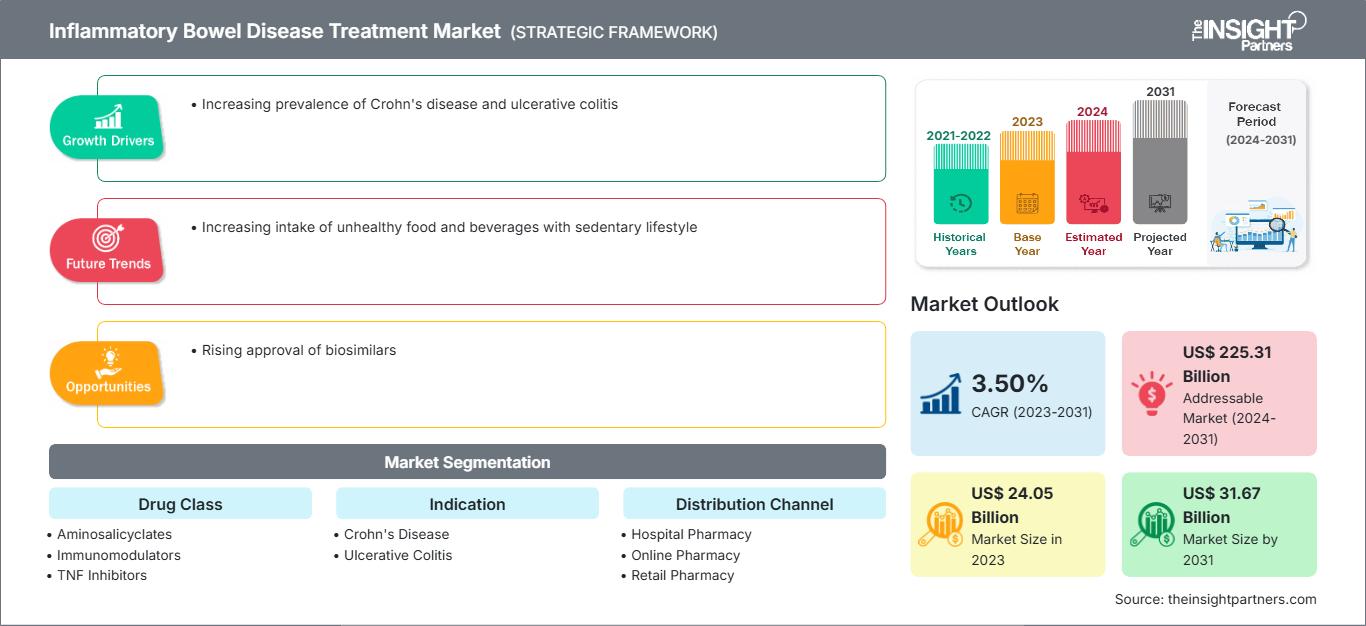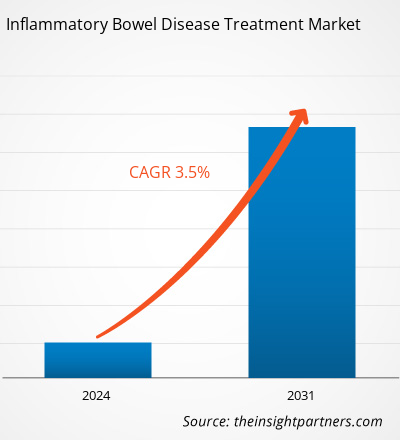炎症性肠病治疗市场价值预计将从 2023 年的 240.5 亿美元增长到 2031 年的 316.7 亿美元;预计该市场在 2023 年至 2031 年期间的复合年增长率将达到 3.50%。
市场洞察和分析师观点:
炎症性肠病 (IBD) 是一种胃肠道慢性炎症性疾病,包括克罗恩病和溃疡性结肠炎。这些疾病会导致消化道内壁发炎,引发腹痛、腹泻、疲劳和体重减轻等症状。治疗旨在通过药物治疗、改变生活方式以及有时进行手术来减轻炎症、控制症状并预防并发症。IBD 的治疗通常需要持续的医疗护理和监测,以维持缓解并改善生活质量。推动炎症性肠病治疗市场增长的关键因素是克罗恩病和溃疡性结肠炎患病率的上升,以及上市产品数量的增加。本报告涵盖了当前炎症性肠病治疗市场趋势及其在预测期内可预见的影响所带来的增长前景。技术进步可能会在未来几年为炎症性肠病治疗市场带来重大趋势。此外,通过持续研究开发创新疗法以及鼓励政府举措也有望推动市场增长。
增长动力与挑战:
克罗恩病是一种复杂的慢性疾病,主要影响消化系统。美国国家医学图书馆 (National Library of Medicine) 指出,2023 年每 100,000 人中有 825 例炎症性肠病 (IBD),其中克罗恩病 410 例,溃疡性结肠炎和 IBD-u 414 例。2023 年,加拿大有 322,600 人患有 IBD,患病率为 0.82%。胃肠道疾病患者由于诊断检查需要禁食、治疗性饮食限制以及厌食或疾病本身导致的营养需求改变而导致的食欲不振,营养不良的风险较高。因此,肠内营养是胃肠道疾病患者的首选,因为肠内途径是提供所需营养的首选途径。因此,克罗恩病和溃疡性结肠炎患病率的上升推动了炎症性肠病治疗市场的增长。
克罗恩病、创伤引起的胃肠道疾病、肠梗阻 (BO)、显微镜下结肠炎、短肠综合征和溃疡性结肠炎是几种常见的胃肠道疾病。根据 2021 年 Healthline 发表的一篇文章,全球约 40% 的人患有功能性胃肠道疾病。加拿大消化健康基金会表示,数百万加拿大人患有消化系统疾病;每年约有 2000 万加拿大人(即每 3 人中就有 2 人)患有消化系统疾病。
另一方面,治疗炎症性肠病 (IBD) 的高昂费用是 IBD 治疗市场面临的一个重大障碍。从昂贵的药物到频繁的住院和手术,管理 IBD 会给患者和医疗保健系统带来沉重的经济负担。成本因素往往会限制许多炎症性肠病 (IBD) 患者获得最佳护理和创新治疗的机会。解决可负担性和可及性问题对于改善这种慢性疾病患者的治疗效果和生活质量至关重要。因此,高昂的治疗费用阻碍了炎症性肠病治疗市场的增长。
自定义此报告以满足您的要求
您将免费获得任何报告的定制,包括本报告的部分内容,或国家级分析、Excel 数据包,以及为初创企业和大学提供超值优惠和折扣
炎症性肠病治疗市场: 战略洞察

- 获取本报告的主要市场趋势。这个免费样本将包括数据分析,从市场趋势到估计和预测。
您将免费获得任何报告的定制,包括本报告的部分内容,或国家级分析、Excel 数据包,以及为初创企业和大学提供超值优惠和折扣
炎症性肠病治疗市场: 战略洞察

- 获取本报告的主要市场趋势。这个免费样本将包括数据分析,从市场趋势到估计和预测。
报告细分和范围:
炎症性肠病治疗市场分析考虑了以下细分市场:药物类别、疾病适应症和分销渠道。根据地域划分,炎症性肠病治疗市场细分为北美(美国、加拿大和墨西哥)、欧洲(英国、德国、法国、意大利、西班牙和欧洲其他地区)、亚太地区(中国、日本、印度、澳大利亚、韩国和亚太其他地区)、中东和非洲(阿联酋、沙特阿拉伯、南非和中东和非洲其他地区)以及南非和中美洲(巴西、阿根廷以及南美洲和中美洲其他地区)。
分部分析:
基于药物类别的洞察
根据药物类别,市场细分为生物制剂、氨基水杨酸盐、皮质类固醇和其他药物。生物制剂在2023年占据了炎症性肠病治疗市场的最大份额,预计在2023年至2031年期间将实现最高的复合年增长率。
基于疾病适应症的洞察
根据疾病适应症,炎症性肠病治疗市场分为克罗恩病和溃疡性结肠炎。预计到 2031 年,克罗恩病领域将占据相当大的市场份额。
基于疾病适应症的洞察
根据分销渠道,市场分为医院药房、零售药房和在线药房。预计到 2031 年,医院药房领域将在炎症性肠病治疗市场占据相当大的份额。
炎症性肠病治疗炎症性肠病治疗市场区域洞察
炎症性肠病治疗市场区域洞察
The Insight Partners 的分析师已详尽阐述了预测期内影响炎症性肠病治疗市场的区域趋势和因素。本节还讨论了北美、欧洲、亚太地区、中东和非洲以及南美和中美洲的炎症性肠病治疗市场细分和地域分布。
炎症性肠病治疗市场报告范围
| 报告属性 | 细节 |
|---|---|
| 市场规模 2023 | US$ 24.05 Billion |
| 市场规模 2031 | US$ 31.67 Billion |
| 全球复合年增长率 (2023 - 2031) | 3.50% |
| 历史数据 | 2021-2022 |
| 预测期 | 2024-2031 |
| 涵盖的领域 |
By 药物类别
|
| 覆盖地区和国家 | 北美
|
| 市场领导者和主要公司简介 |
|
炎症性肠病治疗市场参与者密度:了解其对业务动态的影响
炎症性肠病治疗市场正在快速增长,这得益于终端用户需求的不断增长,而这些需求的驱动因素包括消费者偏好的转变、技术进步以及对产品益处的认知度的提高。随着需求的增长,企业正在扩展产品线,不断创新以满足消费者需求,并抓住新兴趋势,从而进一步推动市场增长。

- 获取 炎症性肠病治疗市场 主要参与者概述
区域分析:
炎症性肠病治疗市场报告的地理范围涵盖北美、欧洲、亚太地区、中东和非洲以及南美洲和中美洲。2023 年,北美占据最大的市场份额。美国以最大的收入份额占据北美市场的主导地位。该国炎症性肠病治疗市场规模的扩大归因于炎症性疾病患病率的激增、主要市场参与者的存在及其战略举措。支付解决方案的改进、高治疗率、创新药物处方的增加、不间断的研究努力以及有利的政府举措也使美国和其他北美国家的炎症性肠病治疗市场受益。克罗恩病和结肠炎基金会是致力于促进旨在治疗结肠炎和克罗恩病的临床和转化研究的著名组织之一。
竞争格局和主要公司:
本报告中提供的炎症性肠病治疗市场预测可以帮助该市场的利益相关者规划其增长战略。AbbVie Inc、武田制药有限公司、辉瑞公司、Biogen、诺华公司、礼来公司、UCB SA、CELLTRION INC.、默克公司和强生服务公司是炎症性肠病治疗市场报告中介绍的几家主要公司。这些公司专注于扩展其产品线,以满足全球不断增长的消费者需求。他们的全球影响力使他们能够服务于众多客户,从而扩大其市场份额。
- 历史分析(2 年)、基准年、预测(7 年)及复合年增长率
- PEST和SWOT分析
- 市场规模、价值/数量 - 全球、区域、国家
- 行业和竞争格局
- Excel 数据集
近期报告
客户评价
购买理由
- 明智的决策
- 了解市场动态
- 竞争分析
- 客户洞察
- 市场预测
- 风险规避
- 战略规划
- 投资论证
- 识别新兴市场
- 优化营销策略
- 提升运营效率
- 顺应监管趋势






















 获取免费样品 - 炎症性肠病治疗市场
获取免费样品 - 炎症性肠病治疗市场